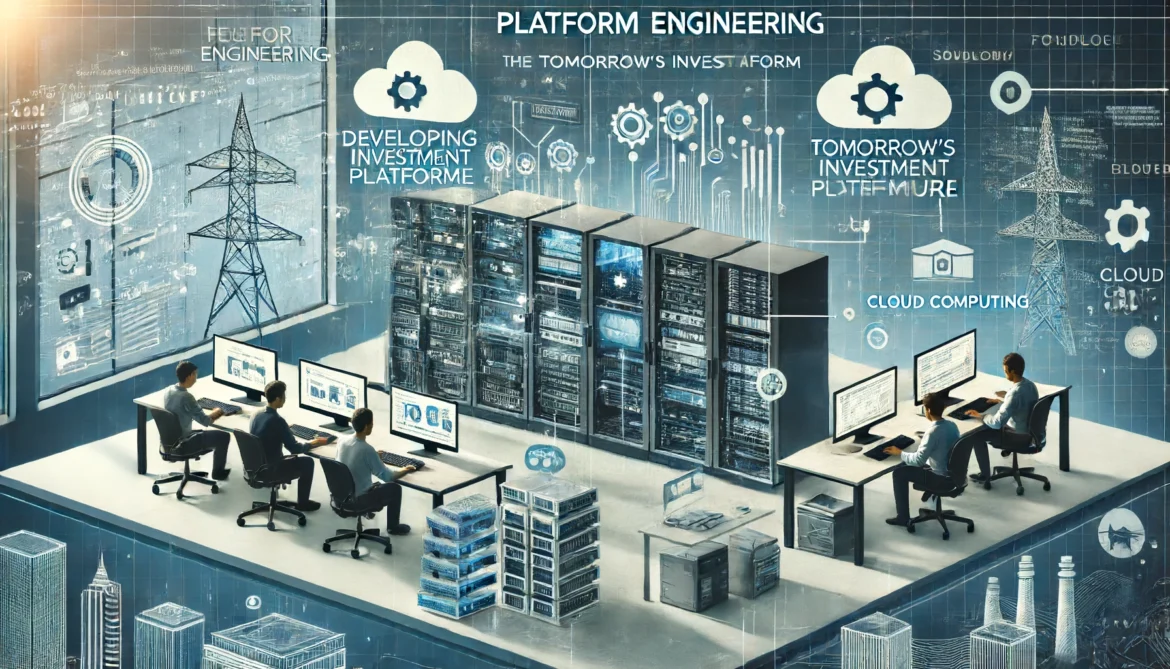Table of Contents
Platform engineering is transforming investment platforms, blending security, efficiency, and user-friendly design seamlessly. Through technologies, these platforms are reshaping how we oversee and expand our investments. Explore how platform engineering is leading the path for the future of services by delivering scalable and personalized investment experiences at magnumator.com.
The Significance of Platform Engineering in Contemporary Investment Platforms
Innovative Foundation; Constructing Strong Structures
Platform engineering serves as the backbone of present-day investment platforms, establishing the groundwork for performance and scalability. It’s akin to designing a blueprint for a skyscraper to ensure each level and space can support the activities within it. Innovative infrastructure focuses on creating systems that are robust yet adaptable to evolving user needs.
A crucial aspect involves utilizing technologies. By using cloud services, investment platforms can adjust their capacity without downtime risks. For instance, these platforms can manage trading volumes during market spikes and offer users service. Cloud providers, like Amazon Web Services (AWS) or Microsoft Azure, offer the resources needed to achieve scalability and dependability.
Moreover, a reliable infrastructure should integrate disaster recovery plans and redundancy measures. This implies that if one part of the system malfunctions, another can step in seamlessly without disrupting the service. Techniques such as load balancing and automatic failover systems play a role in ensuring this transition. They guarantee that during usage periods or unexpected downtimes, the platform stays accessible and operational.
Upholding Trust and Integrity through Security and Compliance
Security and compliance serve as the foundation of any investment platform. Users must have confidence that their personal and financial information is shielded from threats. Platform engineering tackles this requirement by incorporating security measures and adhering to standards right from the start.
Encryption stands out as a security practice. Converting data into a form of encryption ensures that intercepted data remains indecipherable without the appropriate decryption key. This feature is essential for safeguarding details like account information and transaction records. Additionally, platforms employ factor authentication (MFA) to enhance security further, requiring users to confirm their identity through multiple verification methods, such as a password combined with a code sent to their mobile device.
Compliance with regulations holds importance. Investment platforms must comply with laws that vary across different regions. Engineers devise systems of adapting to these requirements, guaranteeing ongoing compliance with evolving regulations.
To ensure security and compliance, investment platforms implement audit trails and reporting mechanisms to monitor transactions and detect any activities effectively.
Conducting security audits and vulnerability analyses is necessary in order to proactively detect and address risks before they can become exploitable by third parties. By prioritizing security measures, investment platforms do not safeguard their users. Also, establish and uphold trust in their services.
Critical Elements of Efficient Platform Engineering
Microservices Architecture: Enhancing Modularity and Adaptability
The adoption of microservices architecture signifies a change in the development and maintenance of applications. Unlike architectures, where components are tightly interconnected, microservices divide applications into smaller stand-alone units. Each microservice is responsible for tasks like user authentication or transaction processing. This modular approach offers benefits for investment platforms.
Firstly, it boosts flexibility by allowing developers to update, scale, or replace microservices independently without impacting the system. This minimizes. Enhances the resilience of the platform to changes and errors. For example, if an update is required for a service managing user profiles, it can be done without disrupting trading activities or other critical functions.
Secondly, microservices promote scalability as different services can be scaled based on demand. During trading periods, transaction handling services can be expanded to manage increased loads while utilized services remain unaffected.
This focused scalability ensures the utilization of resources and peak performance.
Furthermore, microservices support deployment. Updates and enhancements can be introduced gradually, allowing for innovation and timely responses to user input. This strategy aligns with development principles, enabling investment platforms to remain competitive and promptly address user requirements.
Continuous Integration/Continuous Deployment (CI/CD) and DevOps
DevOps marks a shift in how operations are managed, increasing collaboration among development and operations teams and driving software development to be efficient, reliable, and aligned with business goals more closely than ever before. Continuous Integration (CI) and Continuous Deployment (CD) play vital roles here.
Adopting DevOps as part of investment platform software development ensures software that’s effective, reliable, and in line with our business goals; these two practices form its core.
CI entails testing and integrating code modifications from developers into a shared repository. This practice aids in detecting defects and ensures that new code works harmoniously with existing systems. Automated testing tools conduct assessments of the code to identify issues before they impact production. This minimizes the risk of deploying software while upholding platform stability.
CD goes a step further by automating the deployment of code to production environments. Once the code passes all tests, it can be deployed to live servers without intervention.
Frequent and dependable releases are made possible, guaranteeing users access to the features and enhancements.
For investment platforms, Continuous Integration/Continuous Deployment (CI/CD) offers advantages. It facilitates innovation by enabling the secure release of new features and updates. This adaptability is vital in the sector, where maintaining a competitive edge demands continual enhancement and adjustment. Through the adoption of DevOps principles and CI/CD practices, investment platforms can efficiently and consistently deliver top-notch services.
User Experience Impact and Operational Efficiency Enhancement
Improving Performance and Velocity
Performance and velocity play roles in ensuring user satisfaction. A slow platform can annoy users, leading them to seek alternatives from competitors. Platform engineering concentrates on enhancing performance to provide services. This involves employing approaches.
Caching is a method employed to store access data for quick retrieval. By fetching data from the cache of the database platforms can significantly reduce loading times. This proves beneficial for data like user profiles or historical transaction records that change infrequently.
Balancing loads involves spreading network traffic among servers to prevent any server from getting too burdened, which ultimately boosts speed and reliability. Load balancers are essential in handling user requests, managing trading volumes, and maintaining operations without congestion.
Additionally, investment platforms make use of content delivery networks (CDNs) to disseminate content worldwide. CDNs store data copies in locations globally, enabling users to access the platform regardless of location. This minimizes. Enhances the user experience.
Personalization and customization
In today’s landscape, users anticipate experiences tailored to their specific needs and preferences. Data analytics plays a role in achieving this goal. By analyzing user behaviors and choices, platforms can provide investment recommendations and insights.
For instance, an investor inclined towards low-risk investments can receive suggestions that align with their risk tolerance. This level of personalization fosters a sense of value and understanding among users, elevating their experience. Platforms such as Wealthfront and Betterment leverage data analytics to offer tailored investment strategies, aiding users in attaining their objectives efficiently.
Customization also extends to the user interface aspect. Investment platforms empower users to personalize their dashboards by showcasing information based on preferences. This may encompass real-time market updates, portfolio performance metrics, and personalized news feeds. By granting users autonomy over their experience, platforms enhance engagement levels and overall satisfaction.
Moreover, customized notifications and alerts help users stay up-to-date on updates and opportunities. For example, users can receive notifications about market shifts or changes in their investment portfolio value. This proactive approach ensures that users remain engaged and can make investment decisions.
Upcoming Trends in Platform Engineering for Investment Platforms
Integration of Artificial Intelligence and Machine Learning Technologies.
Artificial Intelligence (AI) and Machine Learning (ML) technologies are revolutionizing investment platforms with their integration. These advanced technologies sift through data sets to detect patterns, forecast trends, and streamline decision-making processes – adding them to investment platforms can bring many benefits.
AI and ML play an invaluable role in analysis. By studying data and market trends, AI algorithms can predict asset performance – helping investors make informed choices that could potentially increase returns. Betterment utilizes AI-powered robo advisors such as this one to craft and monitor portfolios explicitly tailored to users’ risk preferences and financial goals.
AI can enhance user experience through natural language processing (NLP). Chatbots and virtual assistants engage with users by answering queries and offering personalized guidance, increasing accessibility as users quickly find information they require without navigating menus.
AI can automate trading strategies. High-frequency trading (HFT) systems use algorithms to perform trades faster and at greater frequency than is possible for individual traders – thus taking advantage of market inefficiencies to boost profits and make trading strategies more effective overall.
Blockchain and Distributed Ledger Technologies
Blockchain technology combines transparency, security, and efficiency – revolutionizing investment platforms. It acts and acts like an electronic ledger that records transactions across computers, ensuring data protection and resistance against tampering.
A key benefit of blockchain is its capacity to facilitate transparent transactions without intermediaries. This can lead to cost savings and enhanced efficiency. For example, blockchain can simplify the settlement process, which typically involves parties and lengthy timelines. By using technology, settlements can be executed instantly, reducing risks and enhancing liquidity.
Moreover, blockchain heightens security measures. Each transaction is documented in a block linked to the preceding one, creating a chain of data blocks. Any attempt to alter the information within a block necessitates altering all blocks in consensus with the network. This feature makes blockchain highly resilient against fraud and manipulation.
Popular cryptocurrencies such as Bitcoin and Ethereum represent applications of technology. The possibilities of this technology go beyond currencies. For instance, smart contracts are contracts that self-execute based on code-defined terms. They automatically. Execute the agreement once specific conditions are met, reducing the reliance on intermediaries and enhancing effectiveness.
Conclusion
In summary, platform engineering plays a role in the development of cutting-edge investment platforms by fostering innovation and dependability. Emphasizing infrastructure, security measures, and user experience guarantees an effective and tailored approach to investing. As technology progresses, platform engineering will continue to influence the future of services by making investments more intelligent and accessible.









